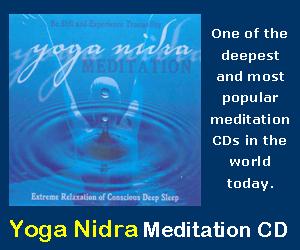|
|
Five
Universal Stages of Meditation
by
Swami Jnaneshvara Bharati
SwamiJ.com
Whatever Gross Object is chosen for
meditation (visualized images, sensation, breath, energy, mantra, or attitudes, etc.), the process moves inward through stages (Gross,
Subtle, Bliss, I-ness, Objectless). All methods of meditation, of all
schools, traditions, teachers, lineages, religions, or paths are
experienced in one or more of the stages described below. This is a
universal framework for deepening meditation, and is extremely useful to
understand, in that it allows you to see where you stand, and where you
are going.
(See Yoga Sutras 1.17-1.18)
| Gross
(Savitarka) |
|
There
are numerous gross level objects on which one can
concentrate for meditation, including physical objects or
their mental forms, attitudes, and a variety of thought
processes. Some schools of meditation base their practice
on only one of these objects. In Yoga Meditation, these are
very important practices, but are seen as preliminary
preparation for the subtler practices. |
| Physical
sensation |
Chakras |
Visualizations |
| Mantra |
Friendliness |
Compassion |
| Breath |
Benevolence |
Acceptance |
| Purity
of mind |
Luminosity |
Thought
streams |
| Energy |
Subtle
senses |
Anything
pleasing |
|
| Subtle
(Savichara) |
|
Beyond
the gross objects of meditation above, there are subtle
level objects. Because these subtle objects are either the
building blocks of the gross objects, or are the mental
instruments of cognition, there are far fewer subtle
objects. For example, all of the objects with shape and
form are built of earth, water, fire, air, and space (bhutas
are gross; tattvas are subtle). All of the
perceptions and attitudes are experienced by the sensing
instruments, which now are themselves objects of
meditation and inquiry. |
| Elements
of earth, water, fire, air, and space |
| The
subtle energy flows of the vayus and pranas |
| The
subtle senses (indriyas) are objects of meditation |
| The
four functions of mind, as objects of meditation |
| The
subtler essence of mantra, beyond the syllables |
|
| Bliss
(Sananda) |
|
When attention goes
beyond the gross and subtle levels of meditation, these recede
into the background, as one is aware of the underlying bliss, a
reality far subtler than mere emotion. In this still subtler
experience, there is a simplicity, in that the multiplicity has
been replaced by the awareness of bliss (ananda). |
| I-ness
(Sasmita) |
|
Beyond all three of
the above levels (gross, subtle, and bliss), there is meditation
on I-ness itself. This is not an ego level, along with the many
personality traits, wants, wishes, images, or forms. Rather, it is
meditation on individuality itself, untainted by all of those more
surface level experiences. Though very deep, it has a simplicity
in that it is a single I-ness, rather than a diversity of choices
of gross or subtle objects. |
| Objectless
(Asamprajnata) |
|
All of the four
stages above have an object on which attention is focused. Thus,
they are called samprajnata, which means with support.
Beyond all of these levels comes objectless attention,
which is without support, and is called asamprajnata.
It is not merely empty-mindedness, but as a vast stillness that is
indescribable to the typical level of waking state mind. |
For greater detail on this process:
Types and stages of meditation
In particular, see the section on:
Stages of Meditation
Objects of meditation are at:
50+ Yoga Meditation Methods
Most methods are described in:
Yoga Sutras

-------
This site is devoted to
presenting the ancient Self-Realization path of
the Tradition of the Himalayan masters
in simple, understandable and beneficial ways, while not compromising
quality or depth. The goal of our sadhana or practices is the highest
Joy that comes from the Realization in direct experience of the
center of consciousness, the Self, the Atman or Purusha, which is
one and the same with the Absolute Reality.
This Self-Realization comes through Yoga meditation of the Yoga
Sutras, the contemplative insight of Advaita Vedanta, and the
intense devotion of Samaya Sri Vidya Tantra, the three of which
complement one another like fingers on a hand.
We employ the classical approaches of Raja, Jnana, Karma, and Bhakti
Yoga, as well as Hatha, Kriya, Kundalini, Laya, Mantra, Nada, Siddha,
and Tantra Yoga. Meditation, contemplation, mantra and prayer
finally converge into a unified force directed towards the final
stage, piercing the pearl of wisdom called bindu, leading to the
Absolute.
|
|
